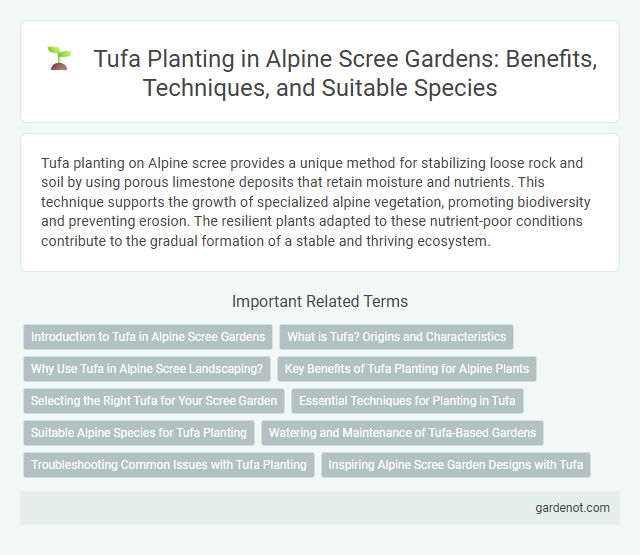Tufa planting on Alpine scree provides a unique method for stabilizing loose rock and soil by using porous limestone deposits that retain moisture and nutrients. This technique supports the growth of specialized alpine vegetation, promoting biodiversity and preventing erosion. The resilient plants adapted to these nutrient-poor conditions contribute to the gradual formation of a stable and thriving ecosystem.
Introduction to Tufa in Alpine Scree Gardens
Tufa, a porous limestone rock formed from calcium carbonate deposits, is ideal for Alpine scree gardens due to its excellent drainage and natural texture that mimics high-altitude environments. This stone promotes moisture retention while allowing excess water to filter through, creating a balanced microhabitat for specialized alpine plants. Its lightweight structure supports root systems of saxifrages and other scree-adapted species, enhancing plant establishment and growth in challenging mountainous landscapes.
What is Tufa? Origins and Characteristics
Tufa is a porous, calcium carbonate rock formed by the precipitation of mineral-rich water, typically found in alpine scree environments where cold, mineral-laden springs emerge. Its lightweight and highly porous structure creates an ideal substrate for specialized plants adapted to nutrient-poor, well-drained scree habitats. Originating from travertine deposits, tufa supports unique alpine vegetation by retaining moisture and providing microhabitats in harsh mountainous landscapes.
Why Use Tufa in Alpine Scree Landscaping?
Tufa is ideal for alpine scree landscaping due to its porous texture, which retains moisture and promotes root aeration, essential for fragile alpine plants. Its natural pH balance supports the growth of calcicole species commonly found in alpine environments. The lightweight nature of tufa reduces soil compaction, enhancing drainage and mimicking the natural erosion conditions of mountain scree slopes.
Key Benefits of Tufa Planting for Alpine Plants
Tufa planting provides essential mineral-rich substrates that enhance moisture retention and root anchorage, creating ideal conditions for alpine plant growth. This porous rock structure supports diverse microhabitats by regulating temperature fluctuations and protecting roots from harsh winds. Its natural alkalinity also improves nutrient availability, boosting the resilience and vitality of alpine flora.
Selecting the Right Tufa for Your Scree Garden
Choosing the right tufa stone for your alpine scree garden involves prioritizing lightweight, porous varieties such as limestone or travertine that enable excellent drainage and root aeration. Select tufas with natural cavities and rough textures to support mosses, alpine succulents, and drought-tolerant plants typical of scree environments. Sourcing tufa from reputable suppliers ensures chemical neutrality, preventing soil pH imbalances that could hinder native plant growth in your scree garden.
Essential Techniques for Planting in Tufa
Successful planting in tufa requires selecting species adapted to the porous, alkaline composition that promotes excellent drainage and aeration for root systems. Essential techniques include securing plants within natural crevices or cavities to stabilize roots and applying minimal, well-draining soil mixes that preserve tufa's structural integrity. Regular watering schedules must account for rapid water loss through tufa's texture, ensuring moisture retention without waterlogging.
Suitable Alpine Species for Tufa Planting
Suitable alpine species for tufa planting include Saxifraga, Androsace, and Draba, which thrive on calcium-rich, porous substrates typical of tufa formations. These plants exhibit strong adaptations to harsh alpine environments, such as drought tolerance and resilience to temperature fluctuations. Their root systems stabilize the fragile tufa surfaces, promoting ecosystem development and biodiversity in scree slopes.
Watering and Maintenance of Tufa-Based Gardens
Tufa-based gardens require consistent watering to maintain moisture levels essential for the porous rock to support plant growth in alpine scree environments. Drip irrigation systems are ideal for delivering slow, deep watering that prevents waterlogging while promoting root health. Regular maintenance involves removing debris and monitoring soil drainage to ensure optimal conditions for delicate alpine species thriving on tufa substrates.
Troubleshooting Common Issues with Tufa Planting
Tufa planting in alpine scree environments often faces challenges like poor drainage, leading to root rot, and difficulty in maintaining moisture balance due to the porous nature of tufa stone. Addressing these issues involves selecting drought-tolerant alpine species and improving substrate mixtures with organic matter to enhance water retention while preventing waterlogging. Regular monitoring for pests and environmental stress can ensure plant establishment and long-term survival in rugged scree conditions.
Inspiring Alpine Scree Garden Designs with Tufa
Tufa, a porous limestone rock, provides an ideal foundation for alpine scree gardens by retaining moisture and offering natural crevices for plant roots. Its lightweight structure supports delicate alpine plants such as saxifrage and edelweiss, enhancing the garden's authenticity and biodiversity. Incorporating tufa into alpine scree designs encourages a thriving ecosystem that mimics natural mountain slopes.
Tufa planting Infographic

 gardenot.com
gardenot.com